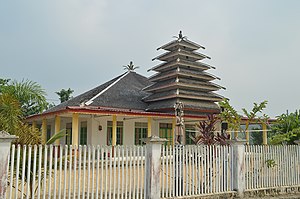
Back كاهارينغان Arabic Kaharingan BAN Кахарынган Byelorussian Kaharingan BJN कहरिंगन Hindi Kaharingan ID Kaharingan MIN Kaharingan Malay กาฮารีงัน Thai 卡哈林干 Chinese
| Kaharingan | |
|---|---|
 The Balai Basarah of Induk Intan, worship place for Kaharingan at Muara Teweh in Central Kalimantan, Indonesia | |
| Type | Folk religion • Indonesian folk religion |
| Scripture | Panaturan |
| Governance | Kaharingan Religious Council (Majelis Agama Kaharingan) |
| Region | Central Kalimantan, South Kalimantan |
| Language | Katingan, Lawangan, Ma'anyan, Ngaju, Ot Danum, and several sub-Dayak language |
| Headquarters | Central Kalimantan |
| Territory | Kalimantan |
| Origin | Central Kalimantan |
| Recognition | Officially recognized by Indonesian government |
| Members | Katingan, Lawangan, Ma'anyan, Ngaju, Ot Danum, Meratus people, Siang Murung people, and several sub-Dayak people |
Kaharingan is an indigenous monotheistic folk religion of the Dayak people such as Katingan, Lawangan, Ma'anyan, Ngaju, Ot Danum people native to the Central Kalimantan and South Kalimantan region in Indonesia.[1]
The word means something like Way of the life, and this belief system includes a concept of many deities and often one supreme deity—although this may be the result of the need to conform to the idea of "One Supreme God" (Ketuhanan yang Maha Esa), which is the first principle of the Indonesian state ideology Pancasila. The influence of Hinduism can also be seen in this religion. Before 2017, the Indonesian government viewed it as a form of Folk Hinduism because the Indonesian government at that time recognized only six official religions, and Kaharingan was not one of them. However, since November 2017, the government started to formally recognize Aliran Kepercayaan, a broadly defined group of native religions which also includes Kaharingan.[1][2]
The main festival of Kaharingan is the Tiwah festival, which lasts for thirty days, and involves the sacrifice of many animals like buffaloes, cows, pigs and chickens, as offerings to the spirits and deities.[3]
The religion has ritual offerings called Yadnya, places of worship called Balai Basarah or Balai Kaharingan and a holy book called Panaturan, Talatah Basarah (group of prayers) and Tawar (a guide to seek God's help by giving rice). Ancestor worship and the belief in many supernatural beings is common.[1][4]
- ^ a b c Belford, Aubrey (2011-09-25). "Borneo Tribe Practices Its Own Kind of "Hinduism"". The New York Times. ISSN 0362-4331. Retrieved 2019-04-18.
- ^ Anthropos, Volume 102, Issue 2, Österreichische Leo-Gesellschaft, Görres-Gesellschaft, Anthropos Institute; Zaunrith'sche Buch-, Kunst- und Steindruckerei, 2007, ... It is remarkable to see how positive and self-conscious Kaharingans currently are in their interior villages. "We are Hindus," they proclaim. Likewise, people in Palangla Raya are proud of being part of a Hindu world community ...
- ^ Greer, Charles Douglas (2008). Religions of Man: Facts, Fibs, Fears and Fables. Bloomington, IN: AuthorHouse. p. 135. ISBN 978-1-4389-0831-1.
- ^ Baier, Martin (2007). "The Development of the Hindu Kaharingan Religion: A New Dayak Religion in Central Kalimantan". Anthropos. 102 (2): 566–570. doi:10.5771/0257-9774-2007-2-566. ISSN 0257-9774. JSTOR 40389742.